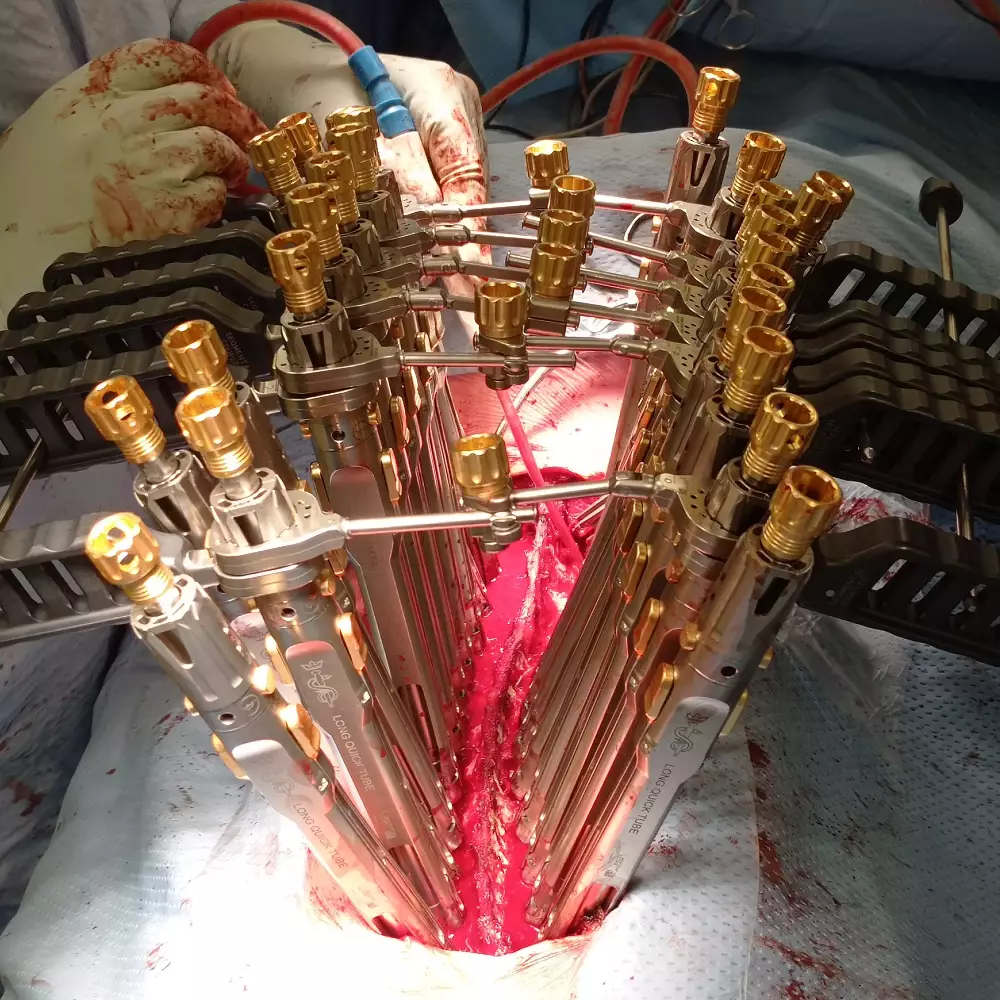Anaesthesia for scoliosis surgery
Scoliosis is a three-dimensional deformity of the spine that can significantly limit patients' quality of life. Therefore, surgery is indicated for severe scoliosis cases in children. In our algorithm, we focus on the differences in preparation, management, and emergence from anaesthesia during this type of surgery. Our patient will have neuromuscular scoliosis caused by Duchenne muscular dystrophy, which brings significant differences and risks that we aim to highlight.
Review
Children with neuromuscular diseases constitute a heterogeneous group of patients for whom the administration of general anaesthesia carries the risk of severe intraoperative and postoperative complications. This makes the algorithm's topic highly relevant for anaesthesiologists. They often encounter cardiorespiratory complications, difficult airway management, and problematic vascular access in children with neuromuscular diseases, which increases the risk of procedures performed under general anaesthesia. For some types of neuromuscular disease, inhalation anaesthetics and succinylcholine can trigger life-threatening reactions, such as malignant hyperthermia, acute rhabdomyolysis, or significant hyperkalemia. These diseases bring certain risks when administering general anaesthesia, necessitating specific perioperative management based on a collaborative team of specialists.
The algorithm presented focuses on anesthesia during the surgical treatment of scoliosis in children with the most severe form of dystrophinopathy, Duchenne muscular dystrophy (DMD). DMD is a progressive neuromuscular disease marked by the patient's progressive muscle weakness.
The algorithm's introductory part highlights the specifics of the preoperative preparation for a child. Before surgery under general anaesthesia in children with DMD, neurological, cardiological, and pneumological evaluations are recommended. The neurological exam confirms the diagnosis and identifies the disease's severity. The pneumological assessment is aimed at estimating the risk of respiratory complications and the necessity for specialized perioperative management. In addition to these exams, it is crucial to evaluate laboratory parameters, including values of the internal environment, acid-base balance, creatine kinase, and myoglobin levels.
An integral part of the algorithm is the correct selection of anaesthetics and an appropriate type of anaesthesia, along with careful patient positioning and blood loss management. Each step is clearly explained, focused on the recommended procedure, leveraging the latest professional knowledge.
The proposed algorithm underscores the need for total intravenous anesthesia (TIVA) in the surgical treatment of scoliosis, requiring individual dosage adjustments and consideration for intraoperative neuromonitoring capabilities. Moreover, in patients with Duchenne muscular dystrophy, as correctly stated in the algorithm, it is advisable to refrain from administering inhalation anaesthetics and succinylcholine due to the increased risk of rhabdomyolysis, hyperkalemia, and possible circulatory arrest.
After a procedure under general anaesthesia, considering the patient's transfer to an intensive care unit for vital sign monitoring is recommended. The final section is specifically focused on postoperative care and the procedure for providing analgesia post-scoliosis correction.
CONCLUSION: The presented algorithm focuses on the key aspects of anaesthesia care during surgical treatment of scoliosis in children with Duchenne muscular dystrophy. It is a valuable educational resource, fully applicable in anesthesiology practice, which I evaluate very positively.
Sources
ANEZ, Cristobal, BECERRA-BOLAÑOS, Ángel, VIVES-LOPEZ, Ariadna and RODRÍGUEZ-PÉREZ, Aurelio, 2021. Cardiopulmonary Resuscitation in the Prone Position in the Operating Room or in the Intensive Care Unit: A Systematic Review. Anesthesia and Analgesia. February 2021. Vol. 132, no. 2, pp. 285–292. DOI 10.1213/ANE.0000000000005289.
EL-HAWARY, Ron and CHUKWUNYERENWA, Chukwudi, 2014. Update on Evaluation and Treatment of Scoliosis. Pediatric Clinics of North America. 1 December 2014. Vol. 61, no. 6, pp. 1223–1241. DOI 10.1016/j.pcl.2014.08.007.
GIBSON, P. R. J., 2004. Anaesthesia for Correction of Scoliosis in Children. Anaesthesia and Intensive Care. 1 August 2004. Vol. 32, no. 4, pp. 548–559. DOI 10.1177/0310057X0403200413.
HAJI MOHD AMIN, Mohamad Zaki, BENG, James Tan Boon, YOUNG, Brian Teo Yian, FARUK SEMAN, Nur Aida, CHING, Teo Shu and CHEK, Wong Chung, 2019. A case of cardiac arrest due to air embolism during scoliosis surgery. Journal of Orthopaedic Surgery. 1 May 2019. Vol. 27, no. 2, pp. 2309499019840083. DOI 10.1177/2309499019840083.
JOHN F. BUTTERWORTH, DAVID C. MACKEY, and JOHN D. WASNICK, 2022. Morgan & Mikhail’s Clinical Anesthesiology. New York: McGraw-Hill Education. 7e. ISBN 1-260-47379-1.
SEKI, Hiroyuki, IDENO, Satoshi, ISHIHARA, Taiga, WATANABE, Kota, MATSUMOTO, Morio and MORISAKI, Hiroshi, 2018. Postoperative pain management in patients undergoing posterior spinal fusion for adolescent idiopathic scoliosis: a narrative review. Scoliosis and Spinal Disorders. 12 September 2018. Vol. 13, no. 1, pp. 17. DOI 10.1186/s13013-018-0165-z.
TINO MÜNSTER, 2019. Anaesthesia recommendations for Duchenne muscular dystrophy. Orphananesthesia. Online. 2019. Retrieved from: https://www.orphananesthesia.eu/en/rare-diseases/published-guidelines/duchenne-muscular-dystrophy/809-duchenne-muscular-dystrophy-2/file.html
VIALLE, R., THÉVENIN-LEMOINE, C. and MARY, P., 2013. Neuromuscular scoliosis. Orthopaedics & traumatology, surgery & research: OTSR. February 2013. Vol. 99, no. 1 Suppl, pp. S124-139. DOI 10.1016/j.otsr.2012.11.002.





